The Crucial m4 (Micron C400) SSD Review
by Anand Lal Shimpi on March 31, 2011 3:16 AM ESTLast week I was in Orlando attending CTIA. While enjoying the Florida weather, two SSDs arrived at my office back in NC: Intel's SSD 320, which we just reviewed three days ago and Crucial's m4. Many of you noticed that I had snuck in m4 results in our 320 review but I saved any analysis/conclusions about the drive for its own review.
There are more drives that I've been testing that are missing their own full reviews. Corsair's Performance Series 3 has been in the lab for weeks now, as has Samsung's SSD 470. I'll be talking about both of those in greater detail in an upcoming article as well.
And for those of you asking about my thoughts on the recent OCZ related stuff that has been making the rounds, expect to see all of that addressed in our review of the final Vertex 3. OCZ missed its original March release timeframe for the Vertex 3 in order to fix some last minute bugs with a new firmware revision, so we should be seeing drives hit the market shortly.
There's a lot happening in the SSD space right now. All of the high end manufacturers have put forward their next-generation controllers. With all of the cards on the table it's clear that SandForce is the performance winner once again this round. So far nothing has been able to beat the SF-2200, although some came close—particularly if you're still using a 3Gbps SATA controller.
All isn't lost for competing drives however. While SandForce may be the unequivocal performance leader, compatibility and reliability are both unknowns. SandForce is still a very small company with limited resources. Although validation has apparently improved tremendously since the SF-1200 last year, it takes a while to develop a proven track record. As a result, some users and corporations feel more comfortable buying from non-SF based competitors—although the SF-2200 may do a lot to change some minds once it starts shipping.
The balance of price, performance and reliability is what keeps this market interesting. Do you potentially sacrifice reliability for performance? Or give up some performance for reliability? Or give up one for price? It's even tougher to decide when you take into account that all of the players involved have had major firmware bugs. Even though Intel appears to have the lowest return rate out of all of the drives it's not excluded from the reliability/compatibility debate.
Crucial's m4, Micron's C400
Micron and Intel have a joint venture, IMFT, that produces NAND Flash for both companies as well as their customers. Micron gets 51% of IMFT production for its own use and resale, while Intel gets the remaining 49%.
Micron is mostly a chip and OEM brand, Crucial is its consumer memory/storage arm. Both divisions shipped an SSD called the C300 last year. It was the first 6Gbps SATA SSD we tested and while it posted some great numbers, the drive launched to a very bumpy start.
| Crucial's m4 Lineup | ||||||||||||||
| CT064M4SSD2 | CT128M4SSD2 | CT256M4SSD2 | CT512M4SSD2 | |||||||||||
| User Capacity | 59.6GiB | 119.2GiB | 238.4GiB | 476.8GiB | ||||||||||
| Random Read Performance | 40K IOPS | 40K IOPS | 40K IOPS | 40K IOPS | ||||||||||
| Random Write Performance | 20K IOPS | 35K IOPS | 50K IOPS | 50K IOPS | ||||||||||
| Sequential Read Performance | Up to 415MB/s | Up to 415MB/s | Up to 415MB/s | Up to 415MB/s | ||||||||||
| Sequential Write Performance | Up to 95MB/s | Up to 175MB/s | Up to 260MB/s | Up to 260MB/s | ||||||||||
A few firmware revisions later and the C300 was finally looking good from a reliability perspective. Although recently I have heard reports of performance issues with the latest 006 firmware, the drive has been working well for me thus far. It just goes to show you that company size alone isn't an indication of compatibility and reliability.
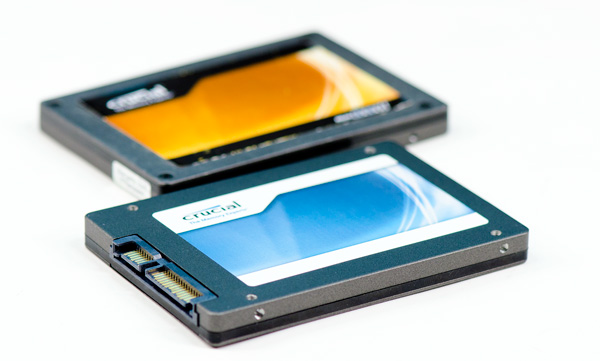
Crucial RealSSD C300 (back), Crucial m4 (front)
This time around Crucial wanted to differentiate its product from what was sold to OEMs. Drives sold by Micron will be branded C400 while consumer drives are called the m4. The two are the same, just with different names.
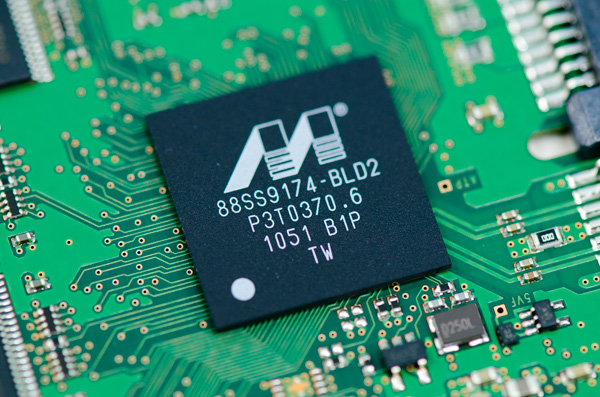
The Marvell 88SS9174-BLD2 in Crucial's m4
Under the hood, er, chassis we have virtually the same controller as the C300. The m4 uses an updated revision of the Marvell 9174 (BLD2 vs. BKK2). Crucial wouldn't go into details as to what was changed, just to say that there were no major architectural differences and it's just an evolution of the same controller used in the C300. When we get to the performance you'll see that Crucial's explanation carries weight. Performance isn't dramatically different from the C300, instead it looks like Crucial played around a bit with firmware. I do wonder if the new revision of the controller is at all less problematic than what was used in the C300. Granted fixing any old problems isn't a guarantee that new ones won't crop up either.
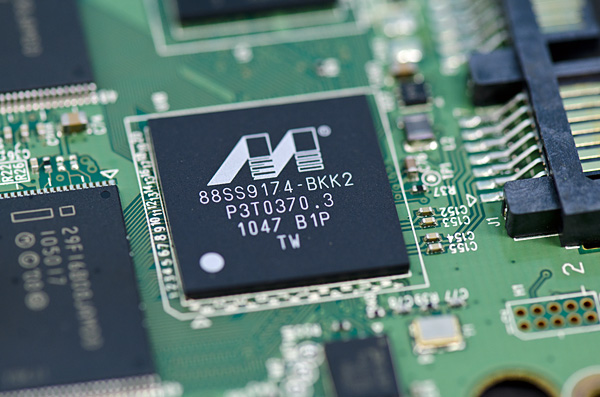
The 88SS9174-BKK2 is in the Intel SSD 510
The m4 is still an 8-channel design. Crucial believes it's important to hit capacities in multiples of 8 (64, 128, 256, 512GB). Crucial also told me that the m4's peak performance isn't limited by the number of channels branching off of the controller so the decision was easy. I am curious to understand why Intel seems to be the only manufacturer that has settled on a 10-channel configuration for its controller while everyone else picked 8-channels.
Crucial sent along a 256GB drive populated with sixteen 16GB 25nm Micron NAND devices. Micron rates its 25nm NAND at 3000 program/erase cycles. By comparison Intel's NAND, coming out of the same fab, is apparently rated at 5000 program/erase cycles. I asked Micron why there's a discrepancy and was told that the silicon's quality and reliability is fundamentally the same. It sounds like the only difference is in testing and validation methodology. In either case I've heard that most 25nm NAND can well exceed its rated program/erase cycles so it's a non-issue.
Furthermore, as we've demonstrated in the past, given a normal desktop usage model even NAND rated for only 3000 program/erase cycles will last for a very long time given a controller with good wear leveling.
Let's quickly do the math again. If you have a 100GB drive and you write 7GB per day you'll program every MLC NAND cell in the drive in just over 14 days—that's one cycle out of three thousand. Outside of SandForce controllers, most SSD controllers will have a write amplification factor greater than 1 in any workload. If we assume a constant write amplification of 20x (and perfect wear leveling) we're still talking about a useful NAND lifespan of almost 6 years. In practice, write amplification for desktop workloads is significantly lower than that.
Remember that the JEDEC spec states that once you've used up all of your rated program/erase cycles, the NAND has to keep your data safe for a year. So even in the unlikely event that you burn through all 3000 p/e cycles and let's assume for a moment that you have some uncharacteristically bad NAND that doesn't last for even one cycle beyond its rating, you should have a full year's worth of data retention left on the drive. By 2013 I'd conservatively estimate NAND to be priced at ~$0.92 per GB and in another three years beyond that you can expect high speed storage to be even cheaper. In short, combined with good ECC and an intelligent controller I wouldn't expect NAND longevity to be a concern at 25nm.
The m4 is currently scheduled for public availability on April 26 (coincidentally the same day I founded AnandTech fourteen years ago), pricing is still TBD. Back at CES Micron gave me a rough indication of pricing however I'm not sure if those prices are higher or lower than what the m4 will ship at. Owning part of a NAND fab obviously gives Micron pricing flexibility, however it also needs to maintain very high profit margins in order to keep said fab up and running (and investors happy).
The Test
| CPU |
Intel Core i7 965 running at 3.2GHz (Turbo & EIST Disabled) Intel Core i7 2600K running at 3.4GHz (Turbo & EIST Disabled)—for AT SB 2011, AS SSD & ATTO |
| Motherboard: |
Intel DX58SO (Intel X58) Intel H67 Motherboard |
| Chipset: |
Intel X58 + Marvell SATA 6Gbps PCIe Intel H67 |
| Chipset Drivers: |
Intel 9.1.1.1015 + Intel IMSM 8.9 Intel 9.1.1.1015 + Intel RST 10.2 |
| Memory: | Qimonda DDR3-1333 4 x 1GB (7-7-7-20) |
| Video Card: | eVGA GeForce GTX 285 |
| Video Drivers: | NVIDIA ForceWare 190.38 64-bit |
| Desktop Resolution: | 1920 x 1200 |
| OS: | Windows 7 x64 |


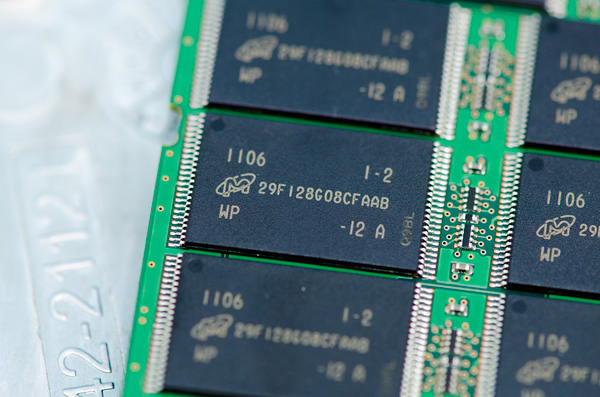
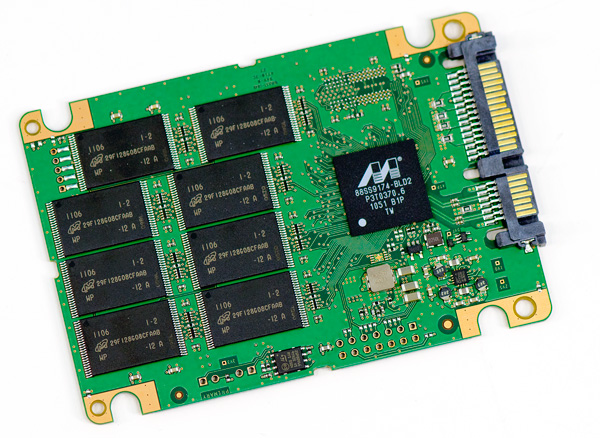
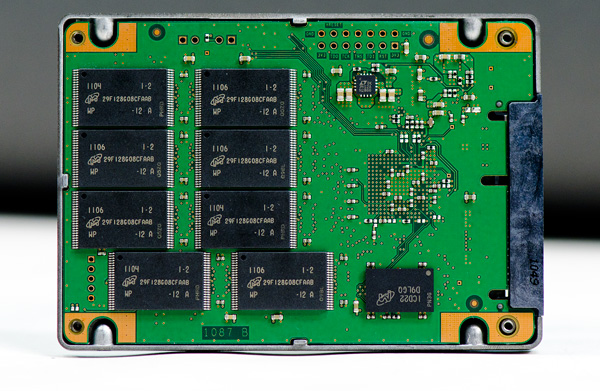








103 Comments
View All Comments
7Enigma - Friday, April 1, 2011 - link
No. You do not. The TRIM command will either run at a set interval or you can do it manually depending on the drive maker (INTEL for instance has a Toolbox that I use once a week or so), and this will return the drive to near-new performance. It's only OS' and drives that do not support TRIM that a complete format (or another method such as copying a large amount of data to the drive and erasing) would be required for this.eamon - Sunday, April 3, 2011 - link
You don't even need that - windows will issue the trim command automatically after a file delete if a block becomes available. You don't need any special driver or special tool; normal use will trigger trims on win7.danbi - Wednesday, April 6, 2011 - link
The typical "OS drive" is "write rarely, read many times". There might be occasional writes to the OS drive, in form of log files, new drivers etc. You rarely, if ever delete files from the "OS drive". Perhaps only when you uninstall software.How would TRIM (supporting OS) ever help in such scenario?
One thing I miss form the "TRIM performance" is what happens when you overwrite already existing files -- pretty common task, by the way.
Another thing, performance with COW file systems, such as ZFS. These file systems will never overwrite data (except metadata) and most of the time writes will be "sequential".
By the way, another missing performance metric is what each drive considers "sequential write". How much KB data in one I/O operations sequential? Is this common with all drives?
faster - Thursday, March 31, 2011 - link
The egg has the RevoDrive 240 GB for $570. The 3rd gen Intel drive is $614 at 250 GB. The new M4 drive is $599?. Price competition in this price point would warrant a comparison in performance. I would like to see the X2 skew the chart to illustrate performance per dollar invested. I understand that the X2 is a PCIE self contained RAID card, but it is a bootable card making it a hard drive competitor. No matter how you feel about it, it would be an interesting comparison from an economic viewpoint.flexcore - Friday, April 1, 2011 - link
Good review! The problem is there are so many different versions of each drive. They change performance characteristics as the size of the drive changes. (Not even getting into OCZ's recent crimes against consumers)I like what MilwaukeeMike brought up about different types of users and how different drives seem to be suited better for different usage patterns. As a AMD user I would also appreciate a review on how these drives perform on AMD platform vs Intel. Then we have TRIM. This is becoming more and more of the normal operational mode, but not always, and what about in RAID configuration.
WOW, these are not the only questions that I continually have been hearing asked on forums around the web. This is a lot of information and work but, you are a leader in SSD reviews. I applaud your efforts ANAND and want to thank you for doing the work you do. I think you are heading in the right direction with your own storage benchmarks, but thats only part of what consumers need. More real world usage to be able discern the actual advances from each new generatin of drive is important also. I look forward to reading more of your insights into where we are and where we are heading with SSD technology.
7Enigma - Friday, April 1, 2011 - link
What we need is some understanding of what is really needed by a SSD. We have all these different benchmarks that are combining IMO way too many tasks at once that a human just cannot perform. Yes it's great to tease out a pretty graph, but what I think most of us want to really see is what is the real-world difference.Things like the Gaming benchmark where there is practically NO difference between current and last-gen drives (hell even the G2 is pretty close) are very important to me so I don't get the upgrade bug for something I really have no major benefit from. Vantage as well.
Anand's said it for a while but there is a huge difference between SSD and mechanical drive, once you upgrade to SSD, however, the improvements for most human workloads (ie non benchmarks) is slim.
I'd love a mini article that would track 4-5 different people's usage models: gamer, web surfer/facebook/iTunes average joe, encoder, and whatever other major "type" of person that frequents Anandtech (it should be biased towards the readership IMO), and then create a benchmark based on that.
We don't need 24 programs opening simultaneously while downloading a torrent and doing a virus scan. What we do need to see is if there is any tangible benefit to 6Gbps SATA over 3 in normal daily use and G1 to Vertex3. If not the numbers are great and if buying a SSD for the first time or building a system OK, but the need to upgrade from an existing SSD is just not there.
Great article btw!
X-Nemesis - Friday, April 1, 2011 - link
This is what I think as well...it does not seem like there is really any real world benefit to upgrade an older generation SSD to the new 6Gbps offerings. The only reason to upgrade would be size at a much cheaper price point.Nicolas Pillot - Friday, April 1, 2011 - link
I'm quite new to the field, and looking at the charts i have a plainly simple (but stupid ?) question : how is it that the read speed are lower than the write speed ?!7Enigma - Friday, April 1, 2011 - link
Make sure you are comparing apples to apples. Sequential read/write will be much higher then random read/write so if you are comparing a random read to a sequential write you will see a discrepancy.iwodo - Friday, April 1, 2011 - link
Just thought Anand you should compare all the 40 - 80GB Range SSD. Since it is very likely that we buy the lower capacity drive then the expensive but also slightly faster SSD.